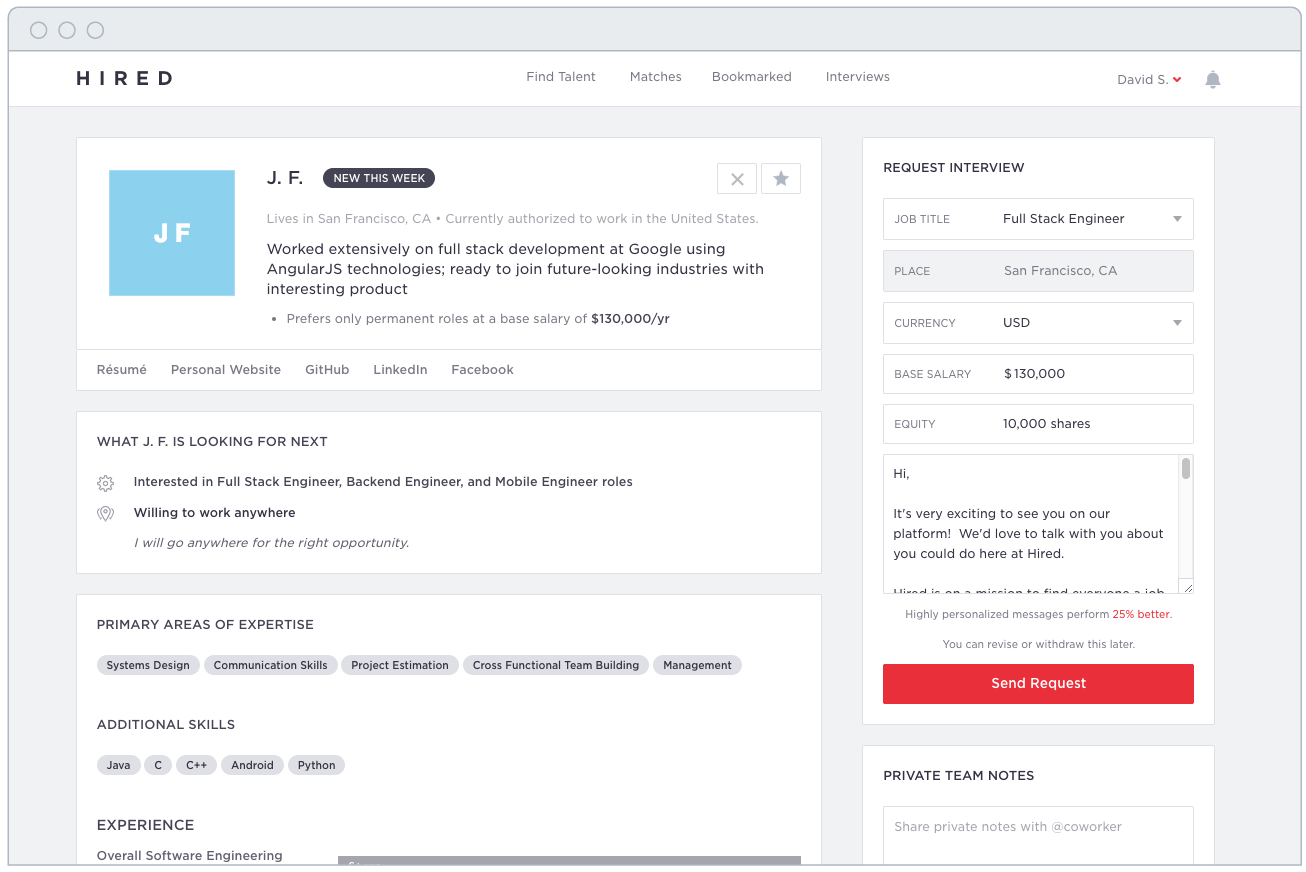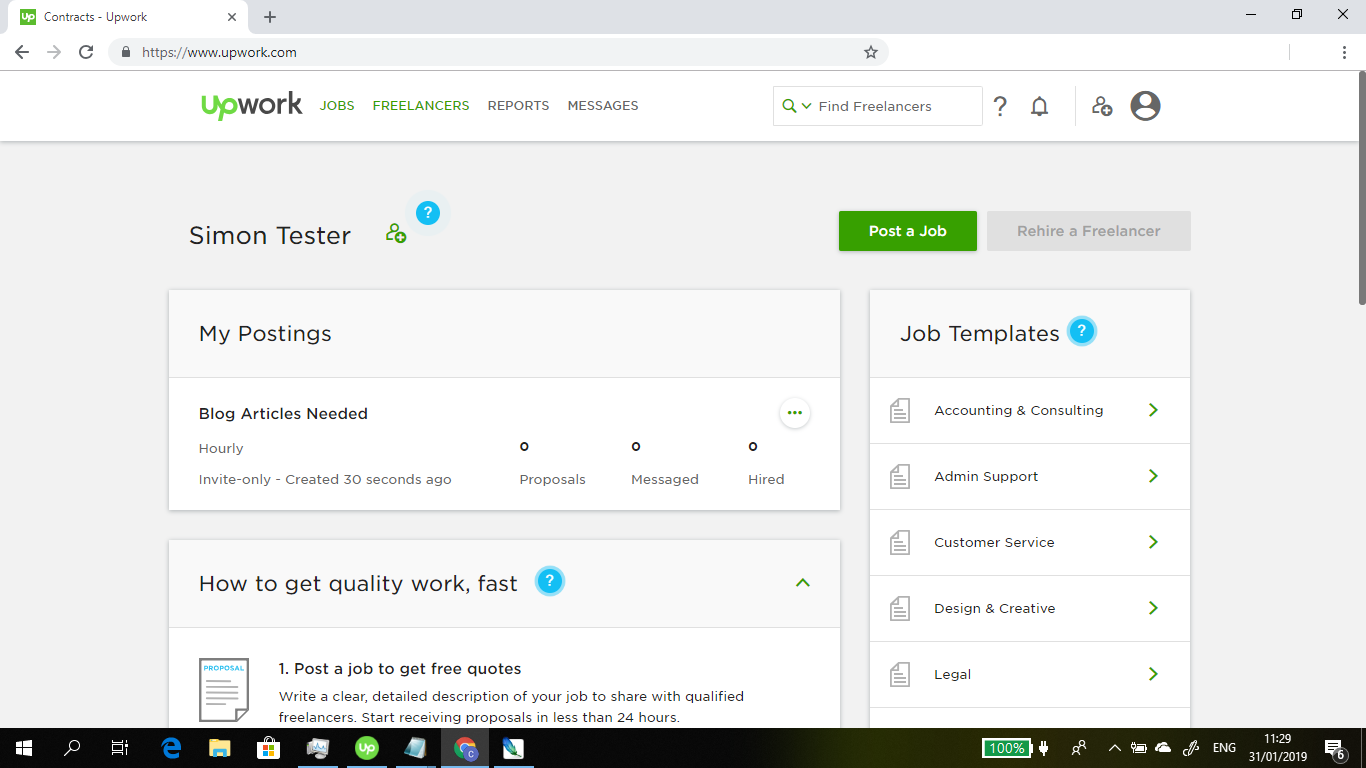Refactored AI Marketplace (hire.refactored.ai)
Refactored AI Marketplace is a platform designed to connect data specialists and hiring managers, addressing the challenges of virtual recruitment in the fields of Data Science and Data Analysis.
June 2019 - Present
Colaberry Inc.
My Role
As the sole designer, I led the design of Refactored Marketplace from June 2019, defining the product vision, design, and development strategy in collaboration with stakeholders and project managers.
The Problem
Hiring managers find it challenging to recruit Data Science and Data Analysis professionals due to the newness of these technologies and the shift to virtual recruitment caused by the pandemic. In addition, data specialists lack a platform to showcase their works and skills. There is no current optimized template for data talent to create and showcase portfolios.
The Solution
Develop a dedicated platform for recruiting Data Analytics and Data Science professionals with a seamless online hiring process. Also, creating a platform for data talent to showcase their skills and project work in a organized and intuitive way.
Strategy
Collaborated with stakeholders to define product features and tech stack, prioritizing features to ensure alignment with user and business goals.
Challenges & Roadblocks
Personalization
Creating a platform using industry standard ways of recruiting and interviewing while ensuring tools and features are easy to use for those who are not tech savy.
Solution: Used industry standard tools and platforms as a guide for the design while simplifying the interface to contain only the basic features needed to accomplish user goals. Also create virtual guides to help with onboarding and using certain features.
Leading Development Efforts as a Designer
The project development was outsourced with only one developer and one project manager. This meant, in addition to the design, I also has to lead the development and Quality Assurance efforts of the project. Having limited knowledge of APIs at the time and zero knowledge of PHP, it was challenging to understand feasibility and setbacks to certain parts of the project.
Solution: Created a process in which helped organize and structure feedback and task management.
Technical Issues:
Faced technical glitches with the platform.
Solution: Resolved through iterative testing and collaboration with developers.
Project Completion
Due to lack of resources and budget, the project is yet to be completed. The process after creating a contract and the billing features remain incomplete and backlogged in the development phase.
Solution: Shipped the platform only utilizing the contractor or talent side for data talent to create, share, and showcase their virtual online profiles and portfolios when interviewing for jobs. This platform is a part of our jobs ecosystem and is the second phase after students finish the learning phase and are ready for employment. Profiles are also searchable and discoverable by hiring managers and they may use the platform to scout and discover new talent as well as scheduling an interview with selected talent.
Metrics & KPIs
User Growth: 20% month-over-month increase in registrations.
Match Rate: 80% of candidates matched with job postings received interview invitations.
Employment Rate: 98% of candidates on the platform got hired.
Feedback: Continuous improvement based on user feedback.
Conclusion
The Refactored AI Marketplace successfully connected data specialists with hiring managers, enhancing the virtual recruitment process for Data Science and Data Analysis roles, even though the platform was incomplete. The real benefits came from the contractor/candidate side where our newly graduated students were able to define what a effective portfolio should look like, putting them in the scope of hiring managers from companies of all sizes and shapes.
Building a marketplace to bring hiring managers and data experts together in one place.
Research & Discovery
Whiteboarding session with managers and stakeholders
Understanding Requirements
In order to better grasp our requirements, I initially focused on our bootcamp graduates as one of our primary user groups. My approach involved seamlessly incorporating the marketplace into the existing job placement process for these graduates. After completing their technical training, graduates proceeded to the Interview Prep Boot Camp (IPBC) phase. During this phase, they undertook a final project, constructed a portfolio and resume, and honed their interview skills through automated mock interview sessions.
To incorporate the marketplace into this process, we encourage graduates to create profiles, referred to as "BIOS," where they showcase their project work in their portfolios. Additionally, they craft digital resumes that direct potential employers back to their marketplace profiles. This integration enabled us to test our designs and validate assumptions regarding what the talent side of the marketplace required.
User Personas
Great design is anchored in a deep understanding of the user. The user research was synthesized into three to four main personas as illustrated below.
Colaberry Graduates & Alumni
General Job Seekers (Data Science & Data Analytics)
Hiring Managers
Recruiters
Competitive Analysis
With a solid grasp of our user base and their needs, my next objective was to identify potential competitors within the market. My aim was to compile a list of the top three competitors and conduct a comprehensive analysis of each platform. I wanted to scrutinize various aspects, ranging from marketing strategies and user journeys to functionality and the methods each platform employed to achieve their final outcomes. This exercise was intended to uncover design patterns and provide valuable insights to inspire the direction of my own designs.






Plan & Ideate
Design Strategy & Planning
Having gained a clear understanding of the product, user requirements, business objectives, and product specifications, I embarked on the process of planning and generating potential solutions. Collaborating closely with the Tech Lead and Project Managers, we engaged in discussions about technology stacks, feature sets, and database synchronization.
My approach included:
1. Brainstorming sessions with the Tech Lead and Project Managers.
2. Mapping out features.
3. Defining task flows.
4. Creating initial rough sketches.
5. Maintaining frequent communication with stakeholders and leadership.
Our overarching strategy was to ultimately integrate the marketplace with our Refactored.ai learning platform. These two platforms were intended to function independently while also working in tandem within the larger Colaberry "Future of Work" Ecosystem. This ecosystem aimed to provide a comprehensive solution for learning and job placement, aligning individuals with the demands of the evolving job landscape.
In the interim, we envisioned the marketplace as a stand-alone platform, integrated into our Colaberry ecosystem but without direct ties to our learning platform.
Developing such a robust platform from scratch was a daunting task, and drawing inspiration from our competitors was essential. I identified the strengths of the platforms I analyzed and amalgamated them into the solution that eventually became Hire.Refactored.
Feature List
Instant Messaging
Virtual Interviews
Virtual Interview Scheduling
Talent Profiles
Easy Portfolio Creation
Company Profiles
Job Posting
Fully Virtual Four-Step Hiring Process
Video Conferencing
Candidate Video Pitch
Team Hiring Collaboration
Job Search
Talent Search
Job Offers & Contracts
Project Management Tool
Document Sharing
Screen Sharing
Custom Secure Billing System
Client Profiles
Job Posting Video Pitch
Custom Invoicing
Timesheets
Job Recommendations & Top Matches
Candidate Recommendations & Top Matches
Rough Sketches & Task Flows
I kicked off the process with initial sketches of the dashboards, envisioning two distinct versions: one tailored for client users and another designed for talent or job seekers. These sketches served as the foundation for mapping out task flows, outlining the various routes users could take to achieve specific objectives, including:
1. Posting a Job
2. Searching For Talent
3. Creating a Profile
4. Searching For Jobs
5. Creating a Portfolio
6. Navigating the Hiring Process
Design, Test, & Iterate
Refining The Talent User Profile Creation Process
The profile creation process first began as a single-page stepper process.
Feedback from users:
“Flipping back and forth from page to page makes the process seem long.”
To address this issue, I devised a one-page scroll design process equipped with anchor points, allowing sections to expand and collapse based on the selected section. Users could effortlessly navigate by either scrolling down the page or using the side menu to access specific sections. While concerns about cognitive load were raised, I decided to implement this approach and observe user reactions.
As development progressed, we encountered challenges with the accordion-style functionality we initially implemented for the sections. Loading issues and overall scrolling performance proved to be problematic. Consequently, I opted to eliminate the accordion functionality and opted to keep each section open at all times, resulting in a more positive response from our users.
Profile Completion Progress: Keeping Incomplete Profiles From Search Results
While collaborating with managers and stakeholders, concerns arose regarding the presentation of candidates in search results. Upon reviewing the search results for talent, it became evident that over 70% of candidate profiles were incomplete. This raised questions about the impact on a candidate's chances of attracting the attention of hiring managers and the rationale behind displaying incomplete profiles.
In response to this issue, I made the decision to exclusively showcase completed profiles in search results. Candidates were now required to ensure their profiles were fully filled out to appear in search results and be visible to hiring managers. This adjustment introduced additional challenges, including determining which sections should be designated as mandatory and devising a method for users to monitor their completion progress and identify completed and incomplete sections.
I proposed a solution that included an information card displaying completion progress and a list of mandatory sections indicating which were complete and which required further attention. Additionally, we implemented inline validation logic to alert users about incomplete fields and sections.
Adding Requests For Rescheduling Virtual Interviews
In our interview scheduling process for client users and candidates, we encountered a testing issue where candidates lacked the ability to reschedule interviews in the event of emergencies or other unexpected situations. Only clients had the privilege to reschedule, even though the interview times were initially based on the candidate's availability. Consequently, when clients rescheduled, the changes were made without the candidate's consent. This often led candidates to initiate communication with clients through messenger to express their unavailability for the proposed rescheduled times.
To enhance the efficiency of this process, I devised a request and approval system. This system empowers either party, whether client or candidate, to suggest a new interview time for rescheduling. However, the proposed changes must be approved by the other party. This adjustment brought greater transparency to the process and eliminated the need for additional communication via messenger to facilitate rescheduling.
Reimagining the Client Dashboard: Making Interviews & Offers More Accessible
Fortunately, I had the advantage of Colaberry's consulting and staffing team at my disposal. This allowed me to conduct platform testing with our in-house hiring managers, recruiters, and sales representatives, all of whom participated in usability studies.
Key Takeaways:
1. Clients expressed a desire for enhanced accessibility to job offers. Currently, clients must access each individual job posting to view offers. They expressed a need for a consolidated view that displays all offers in one place, enabling them to monitor offers on a daily basis.
2. Clients emphasized the importance of improved access to interview information. They sought a feature that would enable them to easily review their interview history, including completed interviews and upcoming ones.
3. Clients also expressed a desire for more detailed information within the displayed statistics. The existing stats were static, but clients wanted the ability to delve into specifics, such as understanding which candidates were viewing their job postings.
4. It became evident that some clients, upon creating new accounts, were uncertain about the next steps. They lacked clarity on what actions they could take. To address this, I revamped the design to incorporate a welcoming message and two call-to-action (CTA) buttons. This not only provided clear guidance for new users but also offered quick access to action items for existing users.





















